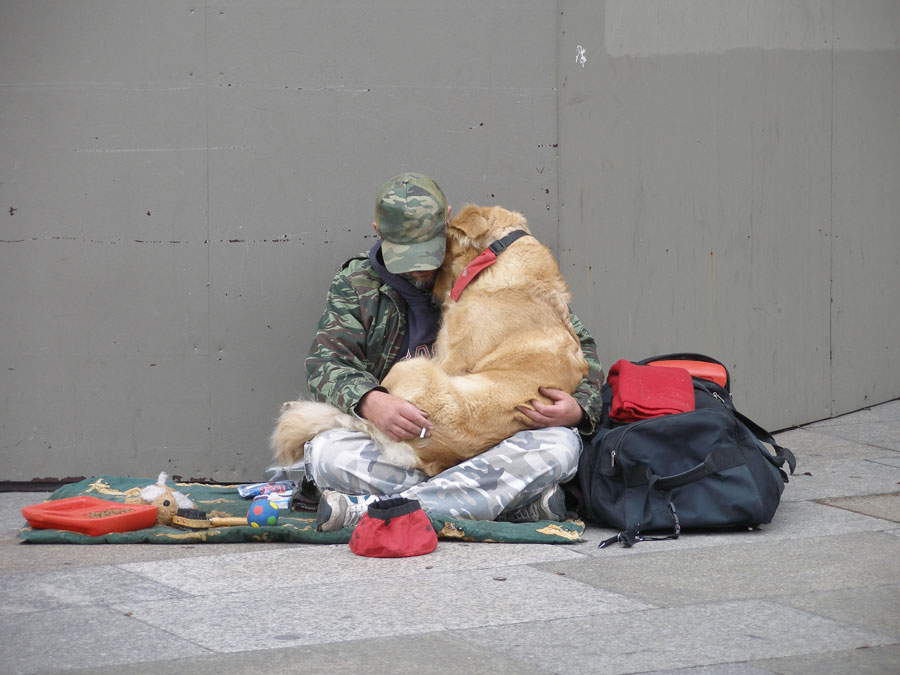Above: Children sleep on a concrete divider above a 20 foot drop into a sewage canal, just outside a Grand Hyatt Hotel in Jakarta, Indonesia. (Image Courtesy: Ross Pollack)

Rates of homelessness are steadily increasing around the world. The number of individuals and families living without homes is growing in both rich and poor nations alike. Estimates vary from 100 million to a whopping 1 billion people living without adequate or any shelter. Particularly alarming is the growing rate of young families and children living without proper shelter. The wide range of estimates can be explained by how exactly scholars, organizations, and governments classify the homeless. The United Nation’s defines homelessness as: “Those households without a shelter that would fall within the scope of living quarters. They carry their few possessions with them, sleeping in the streets, in doorways or on piers, or in any other space, on a more or less random basis.” While this provides a good working definition, this classification merely establishes the minimum standards for homelessness and therefore presents a relatively smaller, and thereby more conservative, estimate of the global population without access to homes.
What factors cause homelessness? Historically, rates of homelessness surge during times of socio-economic and political turmoil. Indeed, in the 20th and 21st centuries’ many conflicts have resulted in large numbers of people being displaced and rendered homeless. For example, in recent decades, the wars in the Balkans and sub-Saharan Africa have uprooted hundreds of millions in places such as Kosovo and the Sudan.
Economic downturns also contribute to homelessness. Periods of major economic slowdowns result in increases in homelessness. In the US for instance, the recent recession forced over 20,000 households into homelessness. High unemployment rates tend to be linked to increases in homelessness among the workforce.
Homelessness in the developing world manifests itself in various ways. Concurrent with growing income inequality and stark gaps in standards of living, rates of homelessness in the industrializing world are on the rise. Industrialization and urbanization are major causes for this increase in many emerging economies. With more people leaving rural areas in search of work in urban centers a housing crisis is brewing. Without enough affordable homes and without proper living wages, many migrant workers are forced to live on the streets. Mumbai, Shanghai, Dubai, and Rio de Janeiro are all rapidly growing cities that attract thousands looking for work. These are also cities with alarmingly high rates of homeless people.
For those living without homes, the health problems created by this paradigm are numerous. In addition to the obvious dangers of exposure to the elements and to the dangers of violent crime, the lack of proper sanitation and medical care increases exposure and susceptibility to various disease. In particular, the common diseases of poverty, such as tuberculosis, particularly affect the homeless. Furthermore, in warm regions with mosquitos and other insects, living outside, without access to protective measures such as bed nets and screened windows, increases exposure to diseases such as malaria.

Homeless youths, a demographic that is growing throughout the world, face numerous challenges. In the United States, for example, approximately 1 out of every 50 children live without proper shelter. In much of the developing world, malnutrition, poor sanitation, and lack of access to clean water increases rates of morbidity and mortality among children without homes. Indeed, homeless children are among the most vulnerable demographics in the world. Without homes and the other basic essentials that directly contribute to childhood development, children suffer. Studies show that homeless children are also often the victims of assault and sexual violence.
A social policy that shows some potential in decreasing homelessness is the Housing First model. The program is based on relatively simple idea: provide homes for homeless families and individuals at little or no cost to the recipients. Rather than employing the more established, and some would argue outmoded, Continuum of Care model of transitional homes and public shelters, programs based on the Housing First model emphasize placing families and individuals into permanent homes and providing them the support and opportunity to develop. The model has had some positive results in pilot programs throughout the US and is currently being replicated in other countries in Europe and Asia.
The concept of Home is a powerful notion – one that evokes emotions of “comfort, belonging, identity, and security.” The Home serves as the core building block around which communities, economies, and nations can grow and thrive. We at ARCHIVE Global believe that access to healthy homes should be a basic human right. While, by no means an easy or simple task, the creation of programs and support systems to adequately ameliorate the conditions of homelessness should be a priority for policy makers and the broader global community in general. We believe that this issue, which stands at the intersection of housing and public health, will be one of the defining challenges of the coming decades. ARCHIVE Global is committed to facilitating a meaningful dialogue in order to allow such topics to occupy a greater space in public debate and discourse than they do presently.
-Riksum Kazi | Operations Officer
